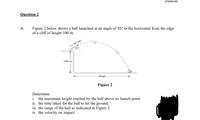
Elements Of Electromagnetics
7th Edition
ISBN: 9780190698614
Author: Sadiku, Matthew N. O.
Publisher: Oxford University Press
expand_more
expand_more
format_list_bulleted
Concept explainers
Question

Transcribed Image Text:ENGS1202
Question 2
A.
Figure 2 below shows a ball launched at an angle of 35° to the horizontal from the edge
of a cliff of height 100 m.
v= 20 m/s
100 m
range
Figure 2
Determine:
i. the maximum height reached by the ball above its launch point.
ii. the time taken for the ball to hit the ground.
iii. the range of the ball as indicated in Figure 2.
iv. the velocity on impact.

Transcribed Image Text:Figure 3 below shows a ball of mass 8.0 kg traveling to the right with a velocity of 6.3
m/s. It collides with a stationary ball of mass 2.4 kg. After the collision, the 2.4 kg ball
moves in a south-easterly direction at 51° below the horizontal.
v=?
v-6.3m's
2.4kg
8.0kg
51°
v=4.5 m's
Figure 3
Determine the velocity of the 8.0 kg ball after the collision.
B.
Expert Solution
This question has been solved!
Explore an expertly crafted, step-by-step solution for a thorough understanding of key concepts.
Step by stepSolved in 2 steps with 6 images

Knowledge Booster
Learn more about
Need a deep-dive on the concept behind this application? Look no further. Learn more about this topic, mechanical-engineering and related others by exploring similar questions and additional content below.Similar questions
- Required information NOTE: This is a multi-part question. Once an answer is submitted, you will be unable to return to this part. Packages are thrown down an incline at A with a velocity of 2.5 m/s. The packages slide along the surface ABC to a conveyor belt which moves with a velocity of 2 m/s. The distance d= 7.5 m and μk = 0.25 between the packages and all surfaces. 2 m/s 7 m B 30° JAM'S Determine the speed of the package at C. (You must provide an answer before moving to the next part.) m/s. The speed of the package at Cisarrow_forwardThe tank is to be placed on a hill that is 1 km high above the ground. The enemy’s base is located at a horizontal distance of 10 km away and it is in a valley 0.5 km below the ground. Air resistance is neglected. Gravitational acceleration is constant and equal to 9.8?/?2 downwards. If the bomb is to be fired perfectly horizontally, what should the launching speed of the bomb be in order to hit the target? What is the duration it would take the bomb to hit the target? Find x(t) and y(t). Consider the initial location of the tank to be (0, 1 km)? Draw the trajectory of the bomb (x and y coordinates). Indicate clearly the value of x (horizontal displacement) when the bomb reaches the ground level. 5. Draw the (?), ??(?), and ??(?) vertical above each other. Indicate key values on the graphs such as the start, the end, the maximum, the minimum and the x and y intercepts. PART 4 and 5 PLEASE.arrow_forwardDYNAMICSarrow_forward
- A projectile is shot directly away from Earth's surface. Neglect the rotation of the Earth. What multiple of Earth's radius RE gives the radial distance (from the Earth's center) the projectile reaches if (a) its initial speed is 0.325 of the escape speed from Earth and (b) its initial kinetic energy is 0.325 of the kinetic energy required to escape Earth? (Give your answers as unitless numbers.) (c) What is the least initial mechanical energy required at launch if the projectile is to escape Earth? (a) Number i (b) Number i (c) Number i Units Units Units ✪ îarrow_forwardLet's see what you gotarrow_forward
arrow_back_ios
arrow_forward_ios
Recommended textbooks for you
 Elements Of ElectromagneticsMechanical EngineeringISBN:9780190698614Author:Sadiku, Matthew N. O.Publisher:Oxford University Press
Elements Of ElectromagneticsMechanical EngineeringISBN:9780190698614Author:Sadiku, Matthew N. O.Publisher:Oxford University Press Mechanics of Materials (10th Edition)Mechanical EngineeringISBN:9780134319650Author:Russell C. HibbelerPublisher:PEARSON
Mechanics of Materials (10th Edition)Mechanical EngineeringISBN:9780134319650Author:Russell C. HibbelerPublisher:PEARSON Thermodynamics: An Engineering ApproachMechanical EngineeringISBN:9781259822674Author:Yunus A. Cengel Dr., Michael A. BolesPublisher:McGraw-Hill Education
Thermodynamics: An Engineering ApproachMechanical EngineeringISBN:9781259822674Author:Yunus A. Cengel Dr., Michael A. BolesPublisher:McGraw-Hill Education Control Systems EngineeringMechanical EngineeringISBN:9781118170519Author:Norman S. NisePublisher:WILEY
Control Systems EngineeringMechanical EngineeringISBN:9781118170519Author:Norman S. NisePublisher:WILEY Mechanics of Materials (MindTap Course List)Mechanical EngineeringISBN:9781337093347Author:Barry J. Goodno, James M. GerePublisher:Cengage Learning
Mechanics of Materials (MindTap Course List)Mechanical EngineeringISBN:9781337093347Author:Barry J. Goodno, James M. GerePublisher:Cengage Learning Engineering Mechanics: StaticsMechanical EngineeringISBN:9781118807330Author:James L. Meriam, L. G. Kraige, J. N. BoltonPublisher:WILEY
Engineering Mechanics: StaticsMechanical EngineeringISBN:9781118807330Author:James L. Meriam, L. G. Kraige, J. N. BoltonPublisher:WILEY

Elements Of Electromagnetics
Mechanical Engineering
ISBN:9780190698614
Author:Sadiku, Matthew N. O.
Publisher:Oxford University Press

Mechanics of Materials (10th Edition)
Mechanical Engineering
ISBN:9780134319650
Author:Russell C. Hibbeler
Publisher:PEARSON

Thermodynamics: An Engineering Approach
Mechanical Engineering
ISBN:9781259822674
Author:Yunus A. Cengel Dr., Michael A. Boles
Publisher:McGraw-Hill Education

Control Systems Engineering
Mechanical Engineering
ISBN:9781118170519
Author:Norman S. Nise
Publisher:WILEY

Mechanics of Materials (MindTap Course List)
Mechanical Engineering
ISBN:9781337093347
Author:Barry J. Goodno, James M. Gere
Publisher:Cengage Learning

Engineering Mechanics: Statics
Mechanical Engineering
ISBN:9781118807330
Author:James L. Meriam, L. G. Kraige, J. N. Bolton
Publisher:WILEY